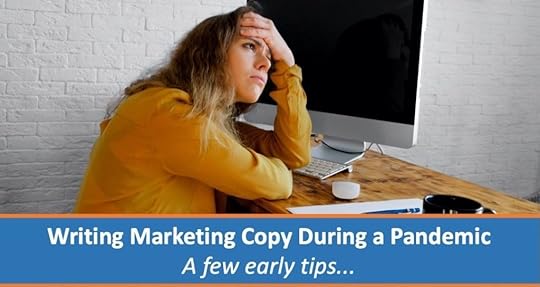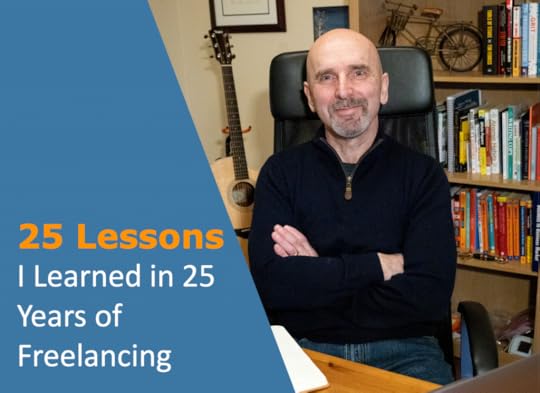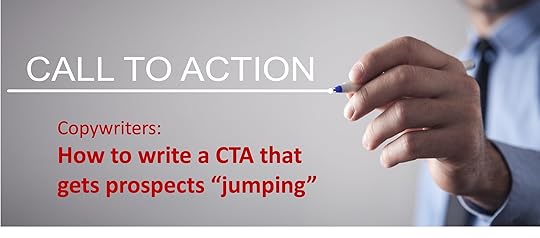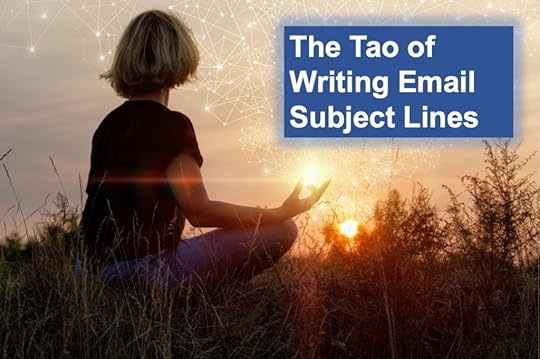Steve Slaunwhite's Blog, page 2
May 11, 2021
6 Starter Questions for Writing Better Sales Copy
 When you’re writing a web page, ad, or email, you need to do some thinking before you begin writing. You need to figure out, roughly, what you’re going to say to persuade prospects to click or buy.
When you’re writing a web page, ad, or email, you need to do some thinking before you begin writing. You need to figure out, roughly, what you’re going to say to persuade prospects to click or buy.
In my copywriting courses, I call this Making Good “Starter” Notes. These can be as formal as a full-blown Creative Brief or as casual as a few bullet points. The format doesn’t matter much. It’s the content that counts.
So what do you put in those starter notes? That can vary, of course, depending on what you’re writing. But you’ll definitely want to nail down answers to these six questions.
1. Who is the prospect?If you’re fuzzy about who you’re selling to, writing the copy will be tedious and painful, and it will likely end up getting poor results. You can’t hit a target you can’t see. That’s why it’s important to clearly define who your prospects — (customers, ideal clients, buyers, whatever you choose to call them) — are.
Who are they? How would you describe them in a sentence?
Say, for example, you’re promoting an online course for real estate agents on how to conduct a virtual open house. In this case, your prospects might be, “Listing agents who are struggling to transition from traditional to virtual open houses.”
2. What do they want?Chances are, your prospects want to either solve a problem, reach a goal, find what they need, get what they desire, or take advantage of an irresistible deal (such as a discount.)
What do your prospects want most that your product, service or offer can give them?
Using the previous example, real estate agents struggle to do virtual open houses. They may not have done them before. The technology confounds them. They worry about losing sales opportunities if they don’t figure this out.
3. How does my product, service or offer give that to them?This question follows the thinking work you did in #2. Often, it’s a simple statement. For example: Our online course teaches real estate agents how to conduct an open house that dazzles buyers and motivates them to make an offer.
4. What are the important features and benefits?Features are facts. Benefits are outcomes.
When making your starter notes, jot down the key features (facts about) your product, service or offer. Then, circle those that are most compelling to your prospects — those most likely to sway them.
For example:
In our online course, we recommend the best tech and apps for virtual open houses.Another key feature…Another key feature…Next, connect benefits (outcomes) to those features you’ve circled. Think about what those features will enable your prospects to solve, do or achieve. Imagine how they’re going to feel when they experience those results.
For example:
In our online course, we recommend the best tech and apps for virtual open houses. That way, you can set things up right the first time, avoiding the misery of making the wrong choices.Another key feature… and its benefit.Another key feature… and its benefit.5. What are the differences?When your prospect has other options — and they usually do! — they’re going to choose your product or service based on what’s different about it, not what’s similar.
So think about differences you can highlight in your sales copy. Those can be just about anything that sets your product or service apart from competitors: a unique feature, a lower price, an advantage. It could even be something about your company, such as its near 5-star ratings on Yelp.
Here’s an example: The course is taught by John Smith, a Realtor who has done more than 30 virtual open houses in the past few months, resulting in 42 offers.
6. What do I want the prospect to do next?Your sales copy must lead the prospect to one place and one place only: the call-to-action. So you must be clear on what that is.
Think about what you want your prospect to do next. Buy now? Learn more? Sign up? Download our free guide? Call us?
Nail down that next step.
So there you have it. Six questions that will help you create better starter notes to guide your copywriting.
You might think this is a lot to do before getting down to it and writing the copy. It isn’t. Unless you’re creating a detailed creative brief, all you’re doing here is jotting down a few points to kickstart your copywriting and keep it on track.
Trust me, it’s worth the few minutes it takes!
This article was originally published in LinkedIn Pulse here.
The post 6 Starter Questions for Writing Better Sales Copy appeared first on Steve Slaunwhite.
5 New Ways to Slay the Blank Page Monster
 There isn’t a copywriter or marketer on the planet who doesn’t face the blank page monster from time-to-time.
There isn’t a copywriter or marketer on the planet who doesn’t face the blank page monster from time-to-time.
Here’s the typical scenario…
You have to write an ad, email or landing page. You need to get that done today. Yet, try as you might, you just can’t string any words together. The ideas won’t come. And all the while, the unfeeling glow of the WORD doc page is beaming back at you, menacingly.
The good news is, there are many practical techniques for getting those first few sentences onto the page quickly—and ultimately getting into the flow.
I’m sure you’ve heard of some of those: create a mind map, sketch out an outline, freewrite, use a template, etc. But if those popular techniques aren’t working for you, here are five more that can often bring that blank page monster to heel.
1. Begin with anything.Most copywriters say that once they nail the first few sentences, the rest of the marketing piece comes more easily. So, try that. Just skip the “nail it” part! Write an imperfect opener. Start with anything—a question, fact, statement, example—and then just keep writing. You can always go back and revise or completely change the opener later.
2. Play with bullets.This technique works well if you know what you want to say but are struggling with how to say it. Simply create a bullet list of the key points and then move them around until a persuasive sequence emerges. Next, look at your first couple of bullets and play with ways to communicate those points with impact. Before you know it, you’ll have written your opener. Then all you have to do is keep going, turning the rest of your list into motivating copy.
3. Paint the promise.Fellow copywriting expert Joanna Wiebe once said that, when writing copy, you’re essentially selling your prospects a better version of themselves. (I couldn’t agree more.) That insight reveals a fast way to jump into your copy. Begin by painting a picture of that “better version” you’re promising the prospect. Make it as vivid and enticing as possible. Then, explain how your product or service can make that happen, by presenting the features, benefits, differences, proof, etc.
4. Skip the opener, for now.Who says you have to write the headline first? Or those first few sentences? If you’re stuck trying to craft your opener, just skip that and move on to another section. Jump in and write the bullet list, the differentiation paragraph, the call-to-action, anything. Think of your marketing piece as a canvas where you can place your brush anywhere and just begin. Soon, you’ll see the copy coming together.
5. Talk it through.Recently, during a corporate training session (via ZOOM), a marketing manager said she was struggling to write a promotional email. I said, “Talk me through what you need to say to motivate the prospect to click.” She then proceeded to do just that as I transcribed her words onto a whiteboard. What emerged, in just minutes, was a solid first draft that needed only a little tweaking. So, if you’re struggling to write your copy, try talking it through. (No one ever gets “talker’s block”.) Before you know it, you might have a decent rough draft.
The blank page monster isn’t going anywhere. It’ll always be lurking, ready to pounce whenever we have an important email, ad or sales page to write. When that happens, try one of these techniques. Just getting a few ideas or copy lines onto the page is often enough to get that monster to skedaddle.
This article was originally published in LinkedIn Pulse here.
The post 5 New Ways to Slay the Blank Page Monster appeared first on Steve Slaunwhite.
July 8, 2020
25 Lessons I Learned from 25 Years of Freelancing
Next month, August 3rd, I’ll be celebrating 25 years as a self-employed copywriter (slash consultant, slash trainer, slash other vocations I’ve tried!) So, I thought it would be interesting to list what I’ve learned about being a successful freelancer for all these years.
Frankly, when I started making this list, I wondered if I had anything helpful to say. But then I realized I must have learned a thing or two that might help my fellow compatriots succeed in this crazy world of solo-ing
So, here goes…
Don’t be a low-end service provider. Offer a premium service; something you can be proud of. Price accordingly.
Never stop marketing. Prospecting, networking, etc. Even when you’re booked solid. Especially when you’re booked solid.
Love your clients. After all, they pay for the many things — if not everything — in your life. (I’m paraphrasing my friend and famed U.K copywriter, Andy Maslen.)
Make friends with fellow solo professionals, ideally those a little more successful than you.
Give new freelancers a helping hand whenever you can. Share your advice, freely. (I have no idea why this works to make you more successful, but it does.)
Pay yourself a regular “salary”. Like a good business owner, commit — really, really commit — to never missing your payroll.
Give your clients a 5-star experience working with you. Every time. Don’t take long-time, regular clients for granted. If anything, you should be giving them a 6-star experience!
Don’t envy successful people in your field. Learn from them.
Strive to be the best at what you do. You may never get there, but that doesn’t matter. It’s the striving that matters.
Don’t miss deadlines. If the client doesn’t give you one, set the deadline yourself. (A tip I learned from Bob Bly.)
If you wake up in the morning not looking forward to your day, something’s wrong. Find out what that is. Fix it, fast.
Return client calls and emails promptly. If possible, the same day.
When you take a day off, really take it off. No work. No emails. No business reading.
Earn a Ph.D in your client’s business. Learn all about what they do, what they sell, who their ideal customers are — and how you can help. You’ll need this to accomplish #15…
Become a linchpin in your client’s business. Be “that guy” or “that gal” who’s indispensable to them. (For a great definition of this, read Seth Godin’s Linchpin.)
Get to know the players. In your field. And in the industry you target.
Reach out to and, if possible, meet with one new contact each week. Ideally, someone who could potentially hire you, recommend you, or just be a valuable professional connection in some other way. (Nod to Lindsay Ratowsky.)
Create a positive, stimulating environment in which to work. For me, that’s my home office, with my paintings adorning the walls, guitar at arm’s reach, favorite books on the shelf. Make your workspace an oasis.
Don’t hang onto the past. Things change. Chances are, you’ll need to update your skills, or do a complete pivot, every couple of years. Don’t be the freelancer who still specializes in software CDs when the industry has moved on to SaaS.
Be good with money. Manage it like Scrooge (after the haunting.) Have enough in the bank to pay your business and personal expenses for at least six months. If you can’t do that now, make it a goal. Even if it takes you five years of scrimping and saving, you’ll be glad you did it.
Take on the occasional tough or unfamiliar project. It will stretch you. Years ago, I taught a 3-day seminar having previously only handled half-day sessions. I was as nervous as an acrophobic about to do a bungee jump. But now multi-day workshops are within my comfort zone.
Act like a consultant, not a temp employee. You’re an equal with your client. You offer a valuable business service. Always present yourself that way.
Success isn’t about getting gigs, it’s about building relationships. One-off gigs will make you tired. Regular clients with recurring projects will make you inspired.
If you’re not getting half your new business through referrals, you’re doing something wrong. Fix it. (Tom Stoyan told me that 20 years ago and I never forgot it.)
Never submit your work to a client unless you’re in love with it yourself. That means doing your best, wow-worthy work, every time.
After 25 years, you might think I follow these tenets religiously these days. Ahhh, noo. Not always. I slip up more times than I care to admit. But, as I said in #9, it’s the striving that matters.
So, my advice to my fellow freelancers is… keep on striving! (Notice how that rhymes with thriving?)
The post 25 Lessons I Learned from 25 Years of Freelancing appeared first on Steve Slaunwhite.
June 23, 2020
Writing a Call-to-Action That Gets Prospects “Jumping”
When I was 21, I jumped out of a plane. It was the main event of a weekend program I took at a local parachute club, which culminated in me voluntarily falling thousands of feet to the ground.
Our instructor’s job, as he saw it, was not only to train us, but also to persuade us.
He knew that many first-timers like me would hesitate at the last moment. So, on the plane — especially when that door opened — he helped to “close the deal”, so to speak, by reassuring us we were ready, we were safe, and doing the jump was going to be an awesome experience.
(Landing on the ground was my favourite part!)
As copywriters, we often need to do the same thing. At the final “decision time” moment in our marketing copy — the call-to-action — many prospects will hesitate. So, we need to encourage them to, figuratively, jump.
In some cases, that’s relatively easy to do.
If you’re writing copy for a familiar brand of watch that sells for $95, you can get away with a simple Buy Now, along with, perhaps, a motivating benefit line alongside it. That’s because that kind of purchase is familiar, low-risk, and not a huge deal.
However, if you’re crafting a sales page to promote a $3,500 leadership skills bootcamp, even the most interested prospect will hesitate at the CTA. At that point in the copy, they may be asking themselves:
“Is this worth the price?”
“Remind me again what’s so great about this?”
“What are previous attendees saying?”
“What’s the urgency? Maybe I can put this off.”
“Is there a guarantee?”
So, when writing call-to-action copy, your first task is to determine how much oomph you need to add to that section. And what that oomph will be.
How do you figure that out? Take the buyer’s journey yourself.
Imagine you’re a typical prospect reading your marketing copy. When you get to the CTA, will you be eager to say yes? Or, will you have questions or objections — or even be skeptical?
Once you’re able to experience the CTA from the prospect’s perspective, you’ll have a clearer idea of what you need to do. That might include:
Adding “reminder” benefits.
Reversing the risk with a guarantee.
Pointing to the consequences of not acting.
Creating urgency.
Making the price seem cheap compared to the value the prospect will be getting.
Building belief with a testimonial.
Or, another of the many CTA copywriting techniques.
As copywriters, we’re not asking anyone to jump out of a plane. (Unless, of course, you write for a parachute club!) But we are asking prospects to overcome their hesitancy and make a buying decision that makes sense for them.
In your CTA copy, help them do that.
The post Writing a Call-to-Action That Gets Prospects “Jumping” appeared first on Steve Slaunwhite.
May 20, 2020
The Tao of Writing Subject Lines
A former training client, Ann, reached out to me last month. She had been struggling with writing subject lines for her email campaigns and wanted my advice.
But first she warned me…
“Steve, I know all the tips, tricks and formulas, so don’t give me more of those! At our company, we track analytics to understand what’s working. We a/b test like mad scientists. We review industry ‘best subject lines’ roundups. Personally, I’ve read just about every article on writing subject lines — and that’s saying something. And, still, I find writing these damn things a pain.”
Worse, it had gotten to a point where her open rates were beginning to decline. Sharply.
“What am I missing here?” she asked, clearly exasperated.
At first, I didn’t know what to tell her. She was, after all, doing all the right things. She should be a subject line-making superstar. Then I asked, “What do you think about when you’re writing a subject line?”
“Well, I think about what I can say to get the email opened.”
When she said that, I suspected she was making the classic mistake many copywriters — including me — sometimes make.
She was focusing on the result, instead of the prospect.
When you tunnel vision on the result, you naturally become manipulative, even if you don’t mean to be. You try this technique and that in order to get prospects to do what you want. In this case, open the email.
So, I advised Ann to switch her focus and think more about the prospect and what they want. I encouraged her to ask:
What’s going on with that prospect at that moment?
What problem, need, or challenge are they likely dealing with right now?
What’s the boulder on their shoulders? What are they concerned about?
What’s their day like at that point? What’s going on in their world?
What is the conversation going on in their head as they check their in-box?
What other types of emails are they likely receiving at that moment?
How can you communicate the value of your email, so it doesn’t stand out as an intrusion?
What is it about your message that is important to them, right now?
What is it about your email that will help them in some way?
Ann thought about it for a moment. Then, with a hint of skepticism in her voice, agreed to give this approach a try.
Why is this mindset so important when writing subject lines? Using this approach of thinking about how to add value to a prospect’s in-box, instead of “technique-ing” them into opening your email, will often result in a subject line that’s more authentic, motivating, and likely to work. And when you combine that with traditional subject line best practices, you’ll write winners more often.
Ann emailed me yesterday and said she’s been using this approach and open rates are going up. “I don’t feel like I’m trying to trick someone to click our emails,” she said. “Subject lines are now much easier to write.”
So, subject line tips, tricks and techniques are fine. Vital, in fact. Learn them. Use them! But don’t forget to think about — even visualize — the prospects you’re sending the email to. What’s in it for them? What’s the value in your message? What can you say in a subject line to communicate your email is worth opening.
The post The Tao of Writing Subject Lines appeared first on Steve Slaunwhite.
May 6, 2020
A Technique for Brainstorming Content Topic Ideas, Fast
I consult and write for a client (let’s call him “Jim”) who produces direct mail newsletters for professionals. You know, the kind you might be receiving regularly from your dentist or investment advisor.
Jim is admirably proactive. He insists on getting the newsletters written waaaaay in advance. In fact, he’s not satisfied unless he has six months of issues in the can.
Well, you can guess where this story is going!
Along comes the pandemic and half those newsletter articles aren’t going to work. Suddenly, my client is in panic mode and asking me to come up with new ideas for article topics. Fast. (Fortunately, that’s a task I’m pretty good at.)
If you’re a freelancer or in-house marketer who manages a blog or e-newsletter then, chances are, you’re knee-deep in the same struggle. The editorial plan just went out the window and you need new content ideas, but quick.
The good news is, there’s a simple technique for brainstorming content topics.
But before I walk you through that technique, keep in mind that a good topic for a blog or newsletter must meet two criteria.
It must be of high-interest to your target audience.
It must position you (or your client) as a go-to provider of what you do or sell.
If your blog post or newsletter article doesn’t check those boxes, then it’s unlikely the piece will get noticed or read.
So, here’s the technique…
First, think about your target audience. If you have a buyer persona handy, pop that up on your screen.
Next, think about what that person’s world is like right now. What challenges are they facing? What goals are they eager to achieve? What pressures are they under? What’s on their front-burner today?
Then, brainstorm a list of topics likely to be helpful to them. Think about tips you can share, stories that might inspire them, insights they can take advantage of, information they need, lessons you can teach them, ideas they can run with, how-tos you can walk them through, and so forth.
Make a long list. Don’t stop until you have at least ten decent ideas.
Once you have those, go through your list and cross off any topic not related to what your company does or sells. There’s no sense publishing a blog post on how to make the ultimate blueberry muffin if your company does big data consulting.
Finally, go through your list and circle those remaining topics that are of high-interest to your audience. Notice I didn’t say “of interest”. High interest. Zero in on those topics likely to gain your audience’s attention and get them clicking and reading.
This brainstorming technique only takes a few minutes. Yet, chances are, you’ll come up with at least a few topic ideas for your blog or newsletter that are golden.
Give it a try. Let me know how it works for you.
The post A Technique for Brainstorming Content Topic Ideas, Fast appeared first on Steve Slaunwhite.
April 20, 2020
For Freelancers: A Day in the Life of a B2B Copywriter
Last week, my friends at AWAI (www.awaionline.com) asked me to record a “Day in the Life” video of a freelance B2B copywriter.
Me!
I’m sure there are some differences in how I spend my day compared to other copywriters. (Anyone else do a Starbucks run at 10am?) But for the most part, I think it’s fairly typical.
If you’re interested in what it’s like to be a freelance B2B copywriter, or want to know how to break into this field, check out the video. You might find it interesting.
By the way, I mention a couple of AWAI resources in this video. Here are the links:
12 Weeks to B2B Copywriting Mastery .
Writing High-Performance B2B Copy.
The post For Freelancers: A Day in the Life of a B2B Copywriter appeared first on Steve Slaunwhite.
April 16, 2020
Writing marketing copy during a pandemic. A few early tips…

Last week, I was asked to re-write several email campaigns for a client. Why? The current copy, which a month ago was just fine, was now out-of-step with all that’s going on. Had my client ran with it, he probably would have received more complaints than sales.
Thus is the challenge for marketers and copywriters during this pandemic. How do you even begin to write effective copy in times like these?
I don’t claim to have all the answers. (No one does.) But I do have some tips, which I share below.
But first let me say: don’t be hard on yourself. No one has done this before. No one has had to write marketing content during a pandemic. So, if you mess up a few times or get pushback on something you wrote, give yourself a break.
We’re all learning as we go.
And here’s what I’ve learned so far…
1.Ease back on the empathy
Yes, your customers want to know you care. Yes, they want your supportive messages. But, as a student in one of my courses said recently, “If I hear from another company asking me how I’m doing through all this, I’m going to scream.”
Most people don’t need to be reminded these are challenging times. So, by all means, tell them that you care. Be sincere about it. Then move on.
I suspect most people are past needing empathy from companies. What they’re interested in now is solutions.
2. Avoid an over-abundance of happy talk
You might be tempted to write something like, “Things will be back to normal soon.” “Everything is going to be fine.” “Look at all the great things you can do on your stay-cation. Woo hoo!”
There’s nothing wrong with infusing your copy with some optimism. In fact, that’s a smart idea. Just don’t lay it on too thick. Otherwise, your marketing message will come across as being out-of-touch or, worse, condescending.
3. Highlight how your helping
If your company (or client) is doing things to help customers through these tough times, consider highlighting that in the copy. Don’t brag about it; just state it, plainly. Customers will appreciate knowing how your company is helping.
More importantly, they’ll remember.
4. Don’t dance around the main marketing message.
When it comes to writing the pitch part of your message — the launch, offer, sale, etc. — get right into it. You don’t need to tread softly or ease into it apologetically, as if you’re sneaking in an uninvited guest to the party. If your product, service, or sale is something that may be useful or valuable to your prospect, present it with confidence.
You don’t need to temper your enthusiasm.
Focus on facts and details.
With so much uncertainty these days, people are craving facts, details and good information.
So, as much as possible, fill your marketing copy with those ingredients. Use plenty of testimonials. Reference highly-credible sources. Quote the latest statistics.
Have you been using a “fact” in your marketing writing that’s getting old? For example, “47% of home buyers say they hate virtual home tours”, says a study from… ah… 2016. A lot can change in four years! Get the most recent information.
Be ultra-realistic about benefits and outcomes.
As every good marketer and copywriter knows, you must paint an enthusiastic, yet realistic picture of benefits and expected outcomes. Otherwise, you won’t be credible. That hasn’t changed. What has changed is that buyers are being extra cautious and scrutinizing the claims made in marketing copy much more closely.
That doesn’t mean you can’t come on strong and persuasive. You definitely can and should. Just double-check that the benefits and promises are realistic.
Update your buyer personas
What are customers thinking about right now? What’s concerning them? What are their hopes and desires? No doubt, the answers are very different than from just a month ago. The pandemic has made all buyer personas out-of-date. So, you need to rethink your audience and get a clear picture of what’s going on for them today.
Okay. Those are some tips I’ve picked up from writing marketing copy during this period. But they’re definitely works-in-progress. Like I said earlier, we’re all learning as we go. (It’s a little like tip-toeing through a mind field.)
Do you have any copywriting tips you can add to this list? Please share in the comments below.
The post Writing marketing copy during a pandemic. A few early tips… appeared first on Steve Slaunwhite.
February 7, 2018
6 “Prep” Questions That Will Help You Write Better Marketing Copy, Faster
Quick question: Would you attempt a cookbook recipe without first getting all the ingredients together?
(Actually, I would. Which is why my wife doesn’t let me near the kitchen!)
When writing marketing copy, getting the “ingredients” together is just as important. You need to have a general idea of what you’re going the say — the key messages — before you start writing. Otherwise, the copy will take twice as long to write and end up being half as good.
So how do you do that?
Fortunately, this step is fairly easy. You just need to answer six questions — which I call “prep” questions. In the video above (appox. 9 minutes), I walk you through each one. I’ve also listed them below, but the video goes into more detail.
Prep Question #1: Who is the prospect, really?
What keeps them up at night?
What’s top-of-mind for them?
Why would they be interested in your product, service or offer, now?
Prep Question #2: What is the problem, need or desire?
How important is this to the prospect?
Do you need to bring the problem, need or desire to the prospect’s front burner?
How are they currently addressing this problem, need or desire? (And why should they do anything different?)
Prep Question #3: What are the features and benefits?
Which are likely to sway the prospect?
If the prospect choose three top features, what would those be?
Which features are better than the competition, or are rare/unique/exclusive?
Prep Question #4: What stories can you tell?
Examples?
Scenarios? (How can you paint a picture of the benefits?)
Customer stories?
Prep Question #5: What proofs can I use?
Testimonials, third-party endorsements?
Awards, accolades, track record?
Statistics, surveys, facts?
Prep Question #6: What is the call-to-action?
Why should they buy now?
What’s the urgency? (How can you create urgency?)
What are the consequences of doing nothing?
The post 6 “Prep” Questions That Will Help You Write Better Marketing Copy, Faster appeared first on Steve Slaunwhite.
January 31, 2018
How to Begin Your Sales Copy With a Story
When I’m running copywriting workshops, two of the most popular questions I get is:
“How do I begin my sales copy? How do I kick it off in a way that’s compelling and holds the prospect’s attention?”
“I’ve heard storytelling can boost my response and conversion rates. How do I use stories in my sales copy?”
So I thought what I’d do this week is combine the two and give you some practical ideas on how to begin your sales copy with a story. In fact, I’ve created a short (5-minute) video lesson on that topic, which you can view above.
But if you prefer reading, here’s that lesson in a nutshell:
Idea #1: Ask a story-prompting question.
This is the simplest way to put the power of storytelling in your sales copy. Start your email, ad or landing page with a question that gets a story started in the prospect’s mind. This can be a winning technique because it’s the prospect, not you, who is creating the story.
Look at this example of an online ad for a training company:
Do you struggle to improve customer service when your retail employees don’t seem to give a damn?
If you manage retail employees, your mind can’t help but replay memories of that happening!
Idea #2: Ask them to imagine.
Here’s an example of the start of a sales page for an online training program.
Imagine if you could contact a list of prospects, introduce your services to them, and land a new client — this week! Without having to do or say anything that’s uncomfortable or exposes you to unpleasant rejection.
What better way to begin your copy than to get the prospect anticipating the happy result of your product or service.
Idea #3: Use an interesting fact or anecdote.
A few years ago, I wrote a very successful direct mail letter for a collections agency. Unlike similar firms, their approach was to help businesses recover overdue accounts without destroying customer relationships.
Here’s how I started that letter:
In ancient Greece, business owners would collect on overdue accounts by throwing stones at the customers. This forced the debtor to pay up or face a daily bruising. Today, things are more civilized, but debt collection is no less frustrating…
Idea #4: Make up a story.
This is the obvious technique. Simply dream up a story that fits your sales message. The famous “Two young men” sales letter for the Wall Street Journal did just that. By some reports, that letter sold more than a billion dollars in subscriptions.
Idea #5: Use a customer story.
Dig into your (or your client’s) treasure trove of customer case studies and testimonials. Using a customer/client story to start your sales copy is powerful because it’s not you singing the praises of your product or service, it’s your customer. That’s convincing.
Idea #6: Get personal.
Use a personal story, either your own or your team’s. This is an ideal approach if building trust and humanizing your product or service is important. If customers/clients “buy you” as much as they buy your product or service, then getting personal can build that needed trust.
So, try one of those ideas the next time you’re writing an email, ad, website page or other type of sales message. Stories have an impact. Stories stick.
The post How to Begin Your Sales Copy With a Story appeared first on Steve Slaunwhite.







